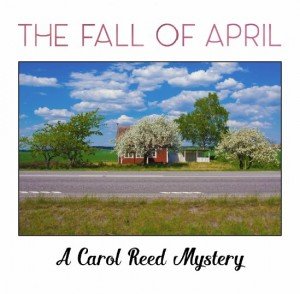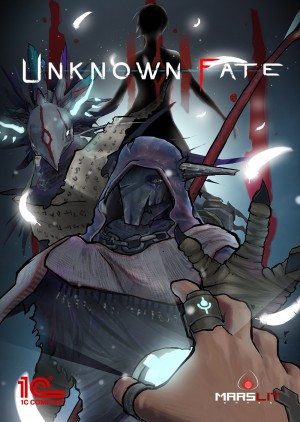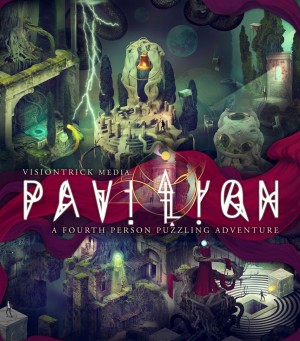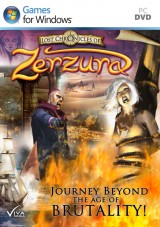Review for Yorkshire Gubbins
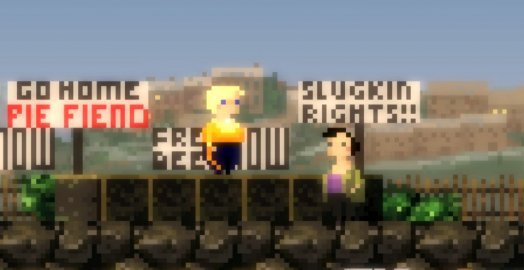
Often the most memorable games are those that just set out to modestly do one thing and do it well, without an AAA budget or a need to reinvent the wheel. This rings true with the very short yet tightly written comedy point-and-click adventure, Yorkshire Gubbins, created by Charlotte Gore and The Stairfall Institute. The game’s first (and so far only) “season” of episodes takes players on a seemingly mundane, yet amusingly ridiculous romp through a small UK community filled with snark, slug monsters, and most importantly, meat pies. If you’re a fan of classic British humour like Monty Python, Mr. Bean, Wallace & Gromit (and plenty others) and enjoy LucasArts-style adventures, this enjoyable little hidden indie gem is for you.
The game as of now has three parts, including a short tutorial that teaches you the basics of “Verb school” (aka the traditional genre menu commands like pick up, use, give, etc.), the longer main episode titled “Humble Pie”, and a prequel called “Holy Molluscamony”, which shows the events leading up to the central story. You don’t have to play the tutorial, and the episodes can be played in any order, though saving the prequel for last is more satisfying, with certain jokes alluding to future events being funnier after the fact. I’ll focus on the “Humble Pie” episode, as it’s easily the longest and most story-heavy of the three.
Yorkshire Gubbins tells the story of Steggy, an unemployed adult living with her mother in a small town somewhere in the titular English county. The game begins with Steggy making her famous meat and potato pie for the annual competition, only to be horrified at the realization that her special meat has been replaced with a normal kind by her best friend. Bertrella explains that because Steggy ruined her wedding only a few days earlier, she wants Steggy to make amends with her, her husband, “Normal Paul” and a slug monster clone of Bertrella, who was also at the wedding. Already what should be a mundane setup is turned on its head in wonderfully satirical fashion, and the people you meet and tasks you do for them continue to escalate the chaos, all for the promise of getting your exceptional ingredient back.
Before getting into the meat of the game, let’s go over the interface since it’s a standard point-and-click affair. The game is a 2D sidescroller, and you can click Steggy left or right or on an object or person to move around four main areas. One complaint with this system is that you can’t hold down your left mouse button to continuously move. Instead you must constantly click for Steggy to walk from one place to another. To remedy this, I ended up just rapidly clicking the far end of the scrolling screen when backtracking. It’s annoying, but nothing that makes the game too tedious as the world itself isn’t big enough to make traveling an issue. All the controls and menu navigating are designated to the mouse, with left-click the usual interaction and right-click acting as a shortcut for default actions such as looking at items, walking through doors and talking to people without needing to select the proper verb first.
The SCUMM-style menu itself isn’t hard to master, but there’s always the handy tutorial episode to help you out if you’re new to this style of play. Verb selection lets you perform different contextual actions to either solve a puzzle or move the plot along, or just try things for fun. If you pick the wrong verb or item, the game will just have Steggy make some offhand comment (such as shouting “No, it’s MINE!” if you attempt to give away items that she refuses to part with in that scenario), so experimentation is encouraged. Except during conversation you have constant access to your inventory, which can be selected for use with other objects or people in the environment. In place of the verbs, dialogue trees appear for almost every character interaction.
The puzzles don’t branch out from the basics of talking to the right people, having the right inventory for a specific situation, or using the correct verb to continue the story. There’s a little bit of scattered item scavenging, but it never falls into pixel hunting territory as all the objects are big enough that you’ll find them even by accident just by scrolling your mouse over the screen. There are a couple of occasions where combining objects to make a new one is necessary, but it’s not brain taxing by any means, and Steggy comments on the items themselves as clues to what you should do next if you click on them in your inventory. If a particular object usage sounds ridiculous, it’s probably the answer to a puzzle. Despite the absurdity, however, this is a good game for genre beginners, as the puzzles aren’t too obtuse and it’s impossible to fail.
While the premise is entertaining, and it’s rewarding to see weird solutions to puzzles play out (even if they are straightforward and easy), Yorkshire Gubbins truly shines in its character interactions. Steggy herself isn’t a usual hero: she’s selfish, broke, and has quite an attitude, often pushing everyone’s buttons when given the chance. That might not have worked for other games, but here every bit of sarcasm Steggy throws out gets dished back to her and then some. The whole cast is delightfully deadpan, ranging from minor characters like Steggy’s disappointed mother and a print shop owner who LARPs as a vampire named Walter, to more plot-relevant characters like the whiney Bertrella, a robot named Terry who hides in a bush, and many more. The everybody-is-a-jerk formula works well thanks to the candid British delivery and makes for very funny exchanges throughout. I was always interested in exploring every possible dialogue option and meeting new characters, as the schtick never came off as forced or unlikeable.
This goes for the heavily-accented voice acting as well, in a game proudly advertising that all its actors are local. This was a wise choice, as although none of them are big names in the industry, they’ve all done an excellent job of conveying the proper emotions and sounding like genuine people. A good example is a man named Boris, whose actor conveys the right amount of anger and conviction needed for the role (and really likes to call one particular character a tosspot). Shout out to Victoria Hudson’s performance as Steggy as well. It takes skill to sound both interested and uninterested at the same time, playing someone who seemingly must always get the last word in no matter who she’s talking to.
The general atmosphere is very quaint, even with all the strange shenanigans everyone gets into. There’s nothing grandiose or overly vibrant about a standard small British town, and this game thrives on understatement. The palette isn’t depressing by any means, making good use of colour for different areas, but it refrains from going overboard to maintain a level of familiarity. The music selection consists of a couple of jaunty but not terribly exciting synthesized tracks (composed by Charlotte Gore herself) that subtly transition into different themes when you enter new areas, which is surprisingly effective and never sounds jarring or distracting. There’s nothing particularly toe-tapping, but the score works to fill the silence in between the sparse sound effects.
The visuals are done in very retro pixel art, all of it blocky. The people who live in this town may be anything but normal, but the places you’ll be walking around are unassuming locales like a residential street, a local park, a small alleyway (or “ginnel” as it’s referred to here) and a shopping street. Even with its minimalist presentation, everything important can be clearly discerned, both in the environment and in inventory close-ups, which are larger and have more detail. If you’re not sure what an object is, hotspot labels when moused over will clear up any doubt. There isn’t a lot of ambient animation, but idle characters are constantly bouncing up and down in place, which adds to the weird charm factor. They can’t physically emote too much, as their faces are only made of tiny squares, but the voice acting and writing more than make up for that. The overall effect is quirky, but it adds to the sense of this world’s uniqueness.
The backdrops also help establish a palpable mood, with overcast weather and buildings butting right up against each other in rural town fashion, creating a comfy feeling in the downtime between zany story moments. By default a “Steggyvision” option is enabled that gives everything in the game more saturated tones and a notable amount of bloom on-screen, which is advertised as “turning the horror of Yorkshire into a fantasy dream world.” For a more truly British experience, I’d recommend turning this off in the main menu, as the grey, earthier palette creates a more authentic atmosphere, but if you prefer the brighter colours the option is available. Either way, the art style is a fine choice for a game of this scope, but if you don’t like chunky pixels, you might find it hard to look at. Yorkshire Gubbins can be played in fullscreen or in a window if it becomes an eye-sore at the larger size.
From a technical standpoint, the game runs well and doesn’t ask for much in terms of hardware requirements. However, I found it finicky when opening through the Steam launcher, such that Steam would consider the game running but be unavailable to play, forcing me to close the program in my task manager to exit out. If you’re having a similar issue with this, using the program’s executable (in the folder where the game was installed) bypasses this issue no problem. This does disable Steam achievements and overlay, unfortunately.
The main episode, “Humble Pie”, was originally meant to be the first in an ongoing episodic series starring Steggy and the rest of the townsfolk. Unfortunately, Charlotte Gore hasn’t announced any further episodes since its launch in 2017. Thankfully the story doesn’t end with a cliffhanger, just a sad reminder that there’s supposed to be a chapter two in the credits. So what you see is likely all you’re going to get, but if you’ve got a few dollars to spare, about two hours of free time, and a fondness for (or at least tolerance of) SCUMM-style retro games, Yorkshire Gubbins is a snappy, often hilarious and competently made British pixel art adventure for those looking to have a laugh.





_capsule_fog__medium.png)




